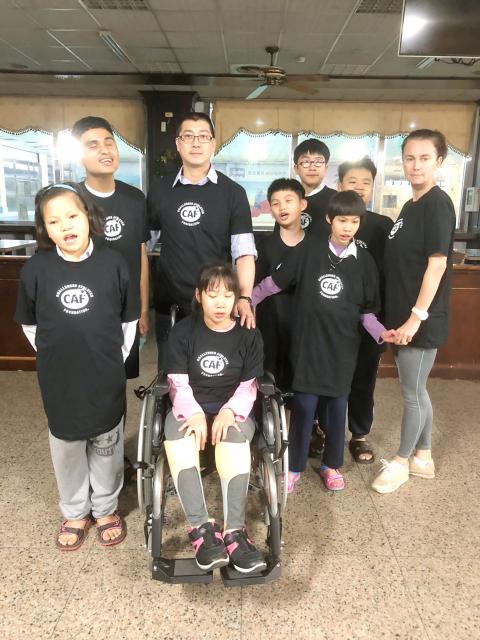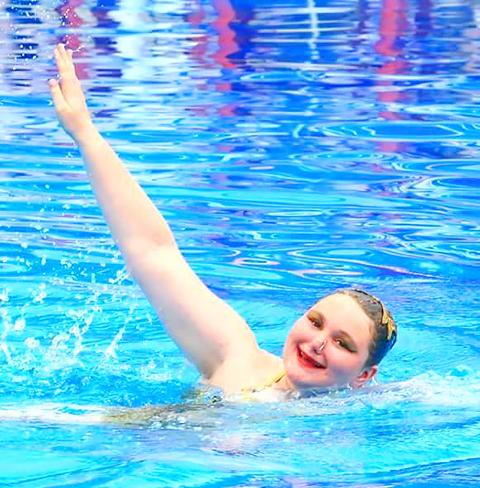Strength. Courage. Beauty.
These three words — all in Chinese — are emblazoned on Ruby Stevens’s blue swimsuit.
Stevens, a 15 year old Canadian swimmer with autism, will wear the self-designed swimsuit when she shows off her synchronized swimming skills this weekend in Taichung.

photo courtesy of Julia Startchenko
“It’s really intense,” Stevens said of her nearly three-minute-long performance, which will feature anime music. Stevens, along with some 50 other swimmers from seven countries, will take part in a synchronized swimming competition on Saturday, and an exhibition on Sunday.
The weekend’s events, held at the North District Civil Sports Center, will include both swimmers with disabilities and those without. Also featured, will be Victoria Shtaf, a synchronized swimmer from the Russian junior national artistic swim team.
One of the hardest underwater moves, Stevens said, is the eggbeater, in which you rotate your legs in opposite directions. Another difficulty, she added, is just remembering to smile.

photo courtesy of Sara Stevens
Stevens, who took to the water at age 2, is also a speed swimmer and an avid painter. These pursuits, she said, are less of a hobby and more of a passion.
“I wake up and I want to go swimming,” Stevens said.
Her mother, though, sees the virtues of swimming beyond just time spent in the pool.
Sara Stevens recalled how her daughter’s autism once lead to struggles with friendships and absences from school. Synchronized swimming, she said, helped her daughter through these difficult times.
“She learned how to overcome challenges,” Sara Stevens said. “It really saved her.”
Ruby Stevens, along with other family members, visited locals schools to talk with students about common themes borrowed from the swimsuit: strength, courage, beauty.
Breaking down social stigmas is a goal for Lai Tzu-ju (賴姿如), president of a local support group for parents with children who are blind.
“They deserve to be seen on the stage overcoming challenges,” said Lai, who will be swimming this weekend with her 12-year-old daughter, Tina Tong (童鈺婷).
Lai admitted that once in the pool in front of others she’ll be more nervous than her daughter, who was diagnosed with cerebral palsy at an early age and also has a degenerative eye condition that will lead to blindness.
Choreographed to the song Hallelujah, the performance will feature the pair moving their arms up and down as if they were flying. The louder the crowd claps, Lai said, the bigger the arm movements.
“She is like a ray of light,” Lai said of her daughter, who excels in math and has a knack for remembering birthday dates.
Aside from the boost in confidence Lai has seen, she has also noticed her daughter getting physically stronger within the year she began synchronized swimming. Coach Julia Startchenko has seen her swimmers’ growth firsthand. This may come in the form of teammates making lasting friendships to increased motivation in and out of the pool.
For example, she said that even on chilly winter days her students are eager to get into the water to start practice. “This is the moment when they grow,” Startchenko said.
This weekend’s events will help foster that growth, with swimmers with disabilities sharing the spotlight with elite swimmers.
While Saturday’s competition, from 10am to 1pm, is open to the public, Startchenko especially encourages the public to attend Sunday’s exhibition, in which the performances are more diverse and lively.
“Something amazing happens with people from different nations coming together,” she said. “It’s very emotional.”
Like ballet in water, synchronized swimming is all about making difficult moves look easy. For swimmers with disabilities, Startchenko said, this can be even more of a challenge.
“We all have unique abilities,” she said. “Beauty can be present in many different ways. It can take the form of a child who is blind getting into the water.”

May 18 to May 24 Pastor Yang Hsu’s (楊煦) congregation was shocked upon seeing the land he chose to build his orphanage. It was surrounded by mountains on three sides, and the only way to access it was to cross a river by foot. The soil was poor due to runoff, and large rocks strewn across the plot prevented much from growing. In addition, there was no running water or electricity. But it was all Yang could afford. He and his Indigenous Atayal wife Lin Feng-ying (林鳳英) had already been caring for 24 orphans in their home, and they were in

President William Lai (賴清德) yesterday delivered an address marking the first anniversary of his presidency. In the speech, Lai affirmed Taiwan’s global role in technology, trade and security. He announced economic and national security initiatives, and emphasized democratic values and cross-party cooperation. The following is the full text of his speech: Yesterday, outside of Beida Elementary School in New Taipei City’s Sanxia District (三峽), there was a major traffic accident that, sadly, claimed several lives and resulted in multiple injuries. The Executive Yuan immediately formed a task force, and last night I personally visited the victims in hospital. Central government agencies and the

Australia’s ABC last week published a piece on the recall campaign. The article emphasized the divisions in Taiwanese society and blamed the recall for worsening them. It quotes a supporter of the Taiwan People’s Party (TPP) as saying “I’m 43 years old, born and raised here, and I’ve never seen the country this divided in my entire life.” Apparently, as an adult, she slept through the post-election violence in 2000 and 2004 by the Chinese Nationalist Party (KMT), the veiled coup threats by the military when Chen Shui-bian (陳水扁) became president, the 2006 Red Shirt protests against him ginned up by

As with most of northern Thailand’s Chinese Nationalist Party (KMT) settlements, the village of Arunothai was only given a Thai name once the Thai government began in the 1970s to assert control over the border region and initiate a decades-long process of political integration. The village’s original name, bestowed by its Yunnanese founders when they first settled the valley in the late 1960s, was a Chinese name, Dagudi (大谷地), which literally translates as “a place for threshing rice.” At that time, these village founders did not know how permanent their settlement would be. Most of Arunothai’s first generation were soldiers